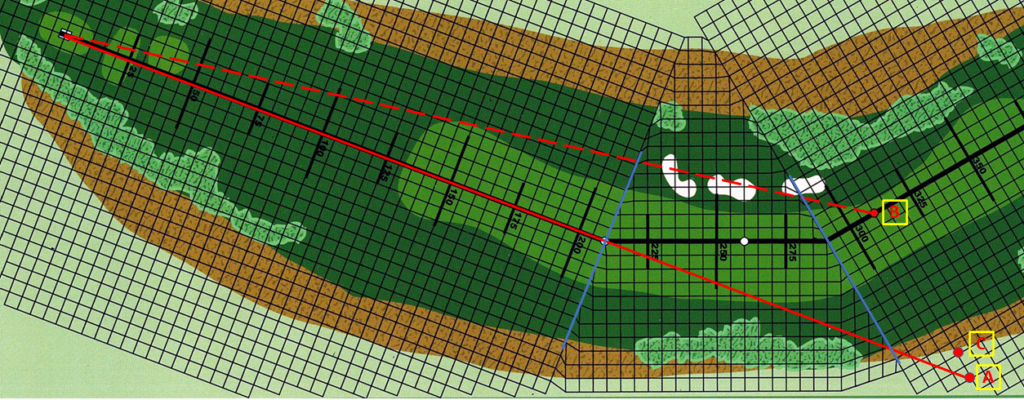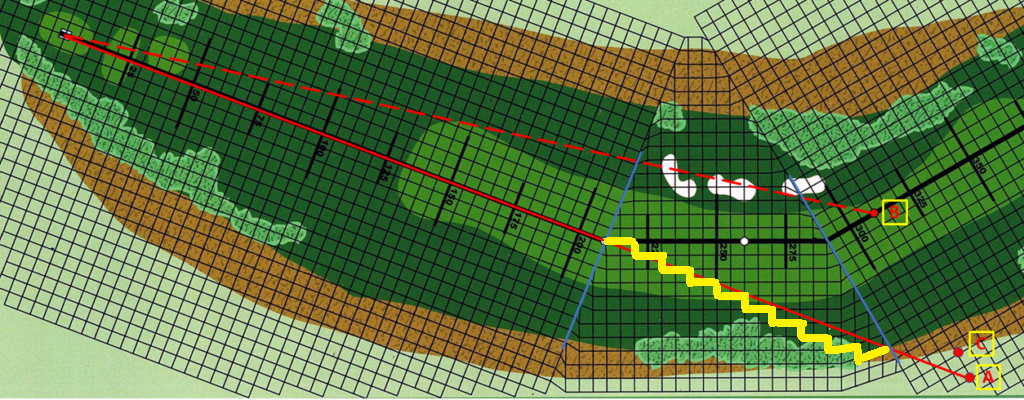Even before the building and testing of GC 4.0, reviewers requested a more advanced DL tool that accounts for a ball crossing a first and second dogleg on a shot. Well, the good news for those folks is that I’m considering adding it in. In this note, I lay out how I might apply it. Before I commit the time to programming, I’d like some more feedback on how it should work.
In the APBA Between the Lines forum and elsewhere, many have have commented about the realism of the APBA rule in the 2014 version of the game. Those rules have the player’s ball moving in the opposite direction of the dogleg for a ball crossing to the inside the dogleg and have the ball moving with or parallel to the centerline (CL) for a ball arriving on the CL or outside of it. Since those rules were published, a modification has become popular in the community that has all shots crossing the dogleg moving in the opposite direction of the turn. Game Caddie users know that it accommodates either approach for a single dogleg. I’ve yet to see anything from APBA or the community on how to resolve a double dogleg, though.
Any new Game Caddie tool will still permit both interpretations, yet it will offer a second dogleg option that will be available through the All in One Menu. It would also warn players when they are blocked by trees (i.e., lack tree clearance) and when crossing a normal or severe dogleg on second and subsequent shots.
I’ve also seen articles that say when you are close to a dogleg, its effects should not be included. Therefore, I am inclined to provide the player with an override for second and subsequent shot situations.
So, why does any of this matter? Let’s take a look at the example below, using hole #5 on Metro D.C. To make it easy, let’s assume the ball goes from tee to target without roll or encountering an obstruction. Both doglegs turn left and are normal–meaning, when the rule applies, the ball travels 5 yards in the opposite direction of the dogleg for every 10 yards the ball travels beyond a dogleg.
- With the original rule, a ball arriving at 310 on the CL, would travel 100 yards beyond the first dogleg (at 210 yards) and 20 yards beyond the second dogleg (at 290 yards). This is represented by point “B” on the chart. Since the ball arrives on the CL, no right movement is required for either dogleg.
- The modified rule has the ball arriving at point “C.” We get there by adding the effect of both doglegs. That means we move right (100/10)*5 = 50 for traveling beyond the first dogleg and (20/10)*5 =10 for traveling beyond the second. That is 60 yards right of the centerline in total.
- For comparison, a shot straight down the first centerline traveling 310 yards would arrive at point “A.”

I’ll let the reader decide which rule (original or modified) is more realistic. While it is pretty clear in the scenario shown, other situations will be different depending of the geometry of the double dogleg, the player’s proximity to the doglegs, length of the shot, and the artist’s rendering of the grid on the chart.
As stated up front, I’d really like your thoughts as to how double doglegs should be handled. Tell me what makes most sense to you. Please post your comments below.

See Craig Benfer’s comment below for an explanation of this image.
I always play the modified dogleg version and I would like to see all the options you suggested. I would like the first dogleg turned off when I’m tooclose for it affect the result. The course itself is really the determining factor on which set of actions is best.
Unless I’m missing something, if the ball travels a total of 310 yards without any right or left deviance, I don’t even have it going past the second dogleg. I have it coming to rest right at the beginning of the second dogleg at 290R45. If it had gone another 20 yards, then I would have just continued to move the ball, but at a 10 yards forward – 10 yards right movement ending at 310R65.
I envision the dogleg modified rule as if there is a slope of the fairway that causes the ball to roll opposite the turn. I usually played these kinds of holes in APBA so I was short of the first dogleg in that condition and it would not affect my second shot to the green as I would play the hole in real life. With a double dog leg then you would have to include the modifier if you are shooting for the green and the shot came up short of the green. I think your example B would be best suited for the carded golfers who could play the course to cut the dog legs and land past the second turn as if they knew what they were doing. The less experienced players of the APBA game and those less rated carded golfers would end up in situation A or B which would be more realistic as well. I’ve played with experienced golfers in real life who cut the corners of doglegs because they knew their shots would make it past the turn(s). Me being an inexperienced, less accurate, less powerful golfer has to play the course to put the ball short of the turn, so I can have more clearance or better ball location to take my next shot. I think you should include this as a toggle for the hole as they present themselves in the game.
I always play the modified rule, and adding the effects from both doglegs as discussed makes sense to me. Automating it should make it easier. I realize the drawing shown is a hypothetical that ignores carry and roll and many other factors. Of these factors, I have found that how the grid lines for doglegs are drawn from course-to-course makes a big difference. The differences among courses makes any (Cartesian-based) formula, such as that used in the game caddie, an approximation (at best) when applied to a specific course. One way to improve the game caddie’s location estimate is to use either the Adjusted Roll or Course Adjustment tools. When moving outside a dogleg, grid lines are often added and the opposite is often true when moving inside the dogleg. How much depends on how far the player’s shot is traveling is inside or outside the dogleg. I just note them and enter difference. Works pretty well and it is fast. As Craig points out, a 310 yard shot would not reach point-A with the modified rule. I see there about 10 grid-lines between 275 and 300 yards in the example. That represents a 25 yard loss on a shot following a normal dogleg path.
I always played as described above. For a normal dogleg ( 5 yard deviation for every 10 yards forward) if the ball was inside the dogleg. Ignoring these effects for balls outside the dogleg. Although I thought this was a strange rule that balls outside the dogleg are not afffected and seem to gain an advantage. If a ball crosses two doglegs then both effects would apply. I personally never had a golfer cross two doglegs on a drive though.
I play the traditional rule (from 2014 Rule Book) ignoring effects for shots outside the dog leg. Although it always seemed to me that trying to cut off the dogleg should be more advantageous. I just figured there was some reason for the rule that was contemplated by the game makers. Perhaps it was the potential added distance lost from hitting outside the dogleg. But cutting the dogleg usually means you are losing distance by aiming. But I think in the scenario above the 2nd dogleg should come into play as it would be a remarkable shot to cut both doglegs But I suppose DeChambeau might! I certainly think having the option via the GameCaddie would be a great addition.
The more I look at this and the intention of the rule and also factoring in what a player is looking at from the tee and what he is trying to accomplish with “cutting off the dogleg” to gain an advantage. On Metro #5 it is my opinion the first dogleg needs to be ignored [shut off by GC] if his initial point of carry takes him past the first dogleg, and then only make adjustments when you hit the 2nd dogleg. The only way I would use the first dogleg effect is if his initial point of carry is before the first dogleg, then I just use that first dogleg effect. On Metro #5 if I am aiming say 15L to cut off the DL, and I hit a nice straight “Average W” shot inside DL, factoring affects of 1st DL and 2nd is too much, no way that ball ends up way in right rough. Just thinking were I am aiming off the tee.
If the question is ‘How would you handle someone hitting the tee shot over both doglegs?’, I would treat the first dogleg as normal, but the second dogleg as severe since I’m comparing it to the original center line. For a 300 yd tee shot, if I’m aiming 15 yds left, I believe I end up at 300 R40. Seems to pass the eye test. By this definition, you would need to aim 55 yds left (if it’s even possible) to end up in the fairway at 345 R20.